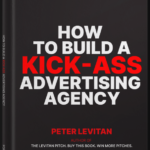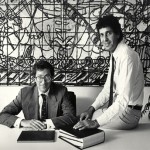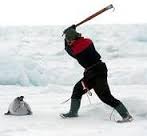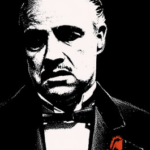A Very Sad Story… The Worst Advertising Agency Presentation – Ever
 This is a story about the worst advertising agency presentation – ever (I know, I was in it.) It was bad.
This is a story about the worst advertising agency presentation – ever (I know, I was in it.) It was bad.
This special experience, along with more stories, strong opinions, and brilliant advice (I’ve learned a lot over the years) is in my new book… How To Run A Kick-Ass Advertising Agency.
If you buy the 27-chapter book and read it, I guarantee that you will win more new business, run a tighter ship, and will make more money.
My First Advertising Agency Presentation
Back to the beginning: I won my first pitch in 1984. For the first email service.
I was an account executive at Dancer, Fitzgerald Sample, New York’s largest “Mad Men” era advertising agency (Saatchi & Saatchi bought Dancer in 1987.) The pitch was for Western Union’s $15 million EasyLink Service. EasyLink was the first commercial email service and launched the same year as the IBM PC – the times were changing fast. We won the pitch and I learned how a well-oiled presentation worked from a new business team that won nine out of ten pitches that year. After I began working on the business, I asked the senior client why we won. She stated three reasons:
- We took the time to do the research to understand this brand-new market. We arrived with the insight that we needed to lead with the consumer-oriented benefit of “Instant Mail” and not the packet-switching story of electronic mail.
- She was dazzled by our presentation technology. We used a large bank of slide projectors (remember this was 1984) to deliver our presentation across a huge screen. Remember, she was a technologist, and our tools were perfectly mated to her mindset.
- She and her team liked our team. The chemistry factor mattered.
After that pitch, my batting average was 1,000. It remains at a Hall of Fame level.
Not all of my pitches went that smoothly and I’ve learned from both the winners and the losers.
Here is the story about the worst advertising agency presentation – ever. I know. I “ran” it.
Saatchi & Saatchi Advertising Worldwide & The Adidas Pitch A Presentation and Pitch We Should Have Won (Duh!)
 In 1992 I was working at Saatchi & Saatchi Advertising’s London office when Maurice Saatchi called me up and told me that we were going to pitch the global Adidas account. Adidas had everything a global agency could wish for: It was a huge brand in a cool category, had a big budget, and powerful competition as Nike was on their world domination tour. Of course, the account would give the agency a potentially great creative platform.
In 1992 I was working at Saatchi & Saatchi Advertising’s London office when Maurice Saatchi called me up and told me that we were going to pitch the global Adidas account. Adidas had everything a global agency could wish for: It was a huge brand in a cool category, had a big budget, and powerful competition as Nike was on their world domination tour. Of course, the account would give the agency a potentially great creative platform.
But wait, wait, there’s more… and it was very personal.
If we won the account, I would open and manage my very own sports marketing agency to run the Adidas account because Saatchi had an existing sporting goods client conflict in the network.
A couple of days after the call, Maurice and the reclusive Charles Saatchi and I met with Robert Louis-Dreyfus, Adidas’ new CEO and majority owner to discuss the pitch. Get this: Robert was a close friend of the agency. He had been the CEO of Saatchi & Saatchi Advertising Worldwide. He was one of us.
Let’s Review
I am working with Maurice and Charles Saatchi – the most famous advertising men in the world.
They asked me to run a huge pitch for the global Adidas account.
Adidas’ CEO is a close friend of the agency, and the management of Adidas America wants us.
If we win the business, I’d build and run my very own Saatchi sports agency. I was already beginning to visualize a reception area adorned with signed World Cup balls, sand, and surfboards. Yes, I was getting way ahead of myself.
But wait, there’s even more good news. During an early meeting, Robert leaned over to me and said:
Peter, you’ve won this business as long as you don’t fuck up the pitch.
I’m thinking, the world’s best agency doesn’t fuck up. I don’t fuck up.
The Pitch & Mistakes
I am now about to tell you how we did, in fact, screw up, and more importantly for you, what I learned.
I think that it is important to point out that this was my first big pitch as Saatchi & Saatchi London’s business development director. I am very happy to say that I’ve gotten much better at pitching during the past 20 years. In fact, years later I won Nike pitches.
Because Adidas would be such a huge win for the agency, the Saatchi brothers wanted to participate directly in the pitch — a rarity at that stage of their careers.
Because Adidas had so much potential, they wanted me to use the creative talents of Jeremy Sinclair (the agency’s global executive creative director) and Paul Arden, another London creative all-star.
I was now working with Charles Saatchi, Jeremy Sinclair, and Paul Arden – three of London’s most famous creatives.
Looking good, right?
Nope. We started to make a whole set of brand-new mistakes right there in Maurice’s old office.
Stay with me, there is a lot of learning here.
Mistake #1
While we all said that it was my pitch to run, I had a room full of owners and very big creative egos (English creative egos are very large). They were difficult to control and rather opinionated.
Lesson: Every pitch needs to establish one leader and manager. Period.
Mistake #2
 My mega-ego creative team was the wrong team for Adidas. They didn’t know sports. They didn’t want to study the market, and these middle-aged guys did not understand the motivations of the younger sports shoe consumer.
My mega-ego creative team was the wrong team for Adidas. They didn’t know sports. They didn’t want to study the market, and these middle-aged guys did not understand the motivations of the younger sports shoe consumer.
Paul even called Nike “nīk.” However, despite his mispronunciation, he did have a BIG idea that was in fact, big. The idea was that sport was akin to GOD. Sports is a key ingredient in our humanity: It brings out the best in us, and it brings the world together.
Through this big idea, Adidas would own the power of sports itself. Yes, that’s a big idea. Unfortunately, the “Ego Team” decided that we needed a video for the pitch to deliver the big idea to Adidas. Paul went out on his own, wrote the script, and produced the video. On his own.
To illustrate this big idea, the video included metaphorical images of man’s inhumanity to man contrasted with the glory of sports. Unfortunately, the imagery went a bit over the top, including images of baby seals being beaten on ice flows and contrasted this hurl-inducing imagery with the beauty of high jumps. To make matters worse, the video didn’t have a budget. You try telling Charles Saatchi how much of his money he could spend on his pitch. The video wound up costing over £30,000.
Lessons: Build the right team for the pitch. In this case, the team was primarily based on seniority and ownership, not a perfect fit. (Note: We did have a savvy account planner and a pitch team also working on the pitch.)
Lesson: Don’t lose control of the process. Establish a budget going in. Stick with it. Don’t give the creative team too much rope.
Just in case you are thinking that I was completely out of my mind, I did ask some of Saatchi London’s other award-winning creative teams to come up with alternative ideas to present alongside the baby seals video. Due to the egos of the “Ego Team,” I had to do this quietly.
Mistake #3
I couldn’t get these guys to rehearse. I rarely got them in the same room at the same time. An advertising agency presentation is theater. Rehearse, please.
Even worse, a couple of days before the pitch, Jeremy began to realize that the baby seal video was going to be difficult to present (a rather large understatement). He then told me that I was going to present all of the creative work.
Lessons: Assign roles based on expertise, not seniority. Stick to a plan. Rehearse and rehearse.
Mistake #4
We knew Robert Louis-Dreyfus very well. But, we didn’t know the Adidas marketing executives. They were not part of the decision to seek a new agency. This pitch was CEO-driven.
In fact, we were not even aware that the Adidas marketing group had already started on a new Adidas campaign approach with London’s Leagas Delaney.
Lessons: Know which clients will be in the room and understand their motivations. I should have realized that the Adidas marketing team did not want to be in the pitch. We could have managed this. However, we were so enamored by our relationship with the CEO and access to internal Adidas information that we didn’t bother to start relationships with the marketing team before the meeting.
We certainly should have known that beating baby seals to death would alienate virtually everyone in the room. Well, my team knew, but we had lost control of that element of the pitch to the “Ego Team” by then.
Mistake #5
This is actually a mistake wrapped up in what is usually a good thing. Maurice opened the meeting with a story. Sir Maurice Saatchi is like the Steve Jobs of pitch storytelling – with the added benefit of an English accent.
We all know that starting with a story is a good thing. However, since we didn’t rehearse, we didn’t know Maurice was going to lead with a story, and we weren’t at all prepared to follow this particular one.
The story turned out to be an involved dream sequence about how ancient Egypt, Pharaohs, and Adidas were alike. During the story, even I was spacing out on visions of the Sphinx and pyramids. In addition to spacing out, I didn’t know that Maurice was going to hand the meeting over to me immediately after he talked about my being in his Egyptian dream. I’m sitting there listening to my very own dream, and then I hear: “Take it Peter.”
The Result?
 As you might suspect, we did not win the Adidas account, and I didn’t get my very own Saatchi & Saatchi sports agency with a wall of World Cup soccer balls.
As you might suspect, we did not win the Adidas account, and I didn’t get my very own Saatchi & Saatchi sports agency with a wall of World Cup soccer balls.
This pitch, a pitch we should have won, quickly became a famous agency story. I now hope it represents a positive teachable moment for all of us.
Key Takeaways:
Here are all of the lessons…
- Every pitch needs a leader and manager.
- Never lose control of the process, which should include a timetable and budget.
- Know which clients will be in the room, their backgrounds, and their motivations. Understanding “buyer” motivations is the key to sales, and pitching is a sales meeting after all.
- Assign agency roles based on expertise, not seniority or “hey, it’s my turn to pitch.” Only your best presenters should ever pitch.
- Don’t give the creative team too much rope.
- Rehearse.
- Consider starting with a story. The right story.
- Don’t show videos of bloodied baby seals.
- Make sure that every idea presented is based on a smart brand strategy that is developed from a deep understanding of the market and brand. We had done market research, but it didn’t directly support the sport-as-God creative concept.


Thanks for sharing your experience. It’s always good to learn and it always seems that people don’t always learn. Ironic. Just hope we can always learn a little bit from the bad experience, remember a little bit, and thendo a little bit better next time. Inch by inch we can be much better eventually.
That’s a well-woven lesson plan. All the elements deserve heavy note and attention, but one that stands out is “rehearse”. It’s always hard to get anyone to do it, and especially to do it 3 times. The 3rd time is invariably way better than the 2nd time. Once everyone knows exactly what to do, they relax, become funny and spontaneous and warm, which is sometimes alone what wins business. When I did this, I usually practiced 10 times in my dining room. In the slide projector and screen days, the practice enabled you to connect with your audience instead of repeatedly turning toward the screen behind you. Now you have a monitor in front of you and screen behind, but you don’t have to look at the monitor much when you know your stuff cold. DFS/Saatchi treated new business like a Broadway show, and it’s why we won so often(at least in NY). When the agency pitched Toyota, with no predicted chance of winning it, the whole agency stayed off the elevators so that when the clients walked in that morning, all elevators would be waiting with the doors open. It wasn’t necessary, but that’s how well everything was coordinated. Of course we won, a life-changing event and the biggest account change in advertising history to that time.
Preston couldn’t have said it any better – all the elements indeed deserve the utmost attention. (This section of the book still makes me chuckle till today and provides such an amazing insight into the life of “big agency”)
Good company is smartbt http://smartbt.by/.
Good lesson plan.
Best coinsbit news https://cointelegraph.com/explained/margin-trading-explained
Peter: I had the SAME experience with Maurice Saatchi and Jeremy Sinclair. I was the acting CMO for Cadbury Beverages and I fought with a few marketing directors in countries like France and Belgium to include Saatchi in the pitch for Scweppes Tonic. I couldn’t get any feedback about how it was going and no one wanted my input as I was American and they were English so knew more about Schweppes than I did. I brought my boss, the President ad the head of Northern Europe and the ehad of Southern Europe, and we all watched everything for the first time. They hadn’t rehearsed. They hadn’t read my brief with facts and the advertising/marketing challenge clearly identifed and supported with research. It was a bumbling disaster and the work was probably relevant 20 years previously. As we left the presentation, my boss said, “Next time maybe you should listen to the marketing directors who report to you….” Well, you know how I felt.
My Best,
ML Sirianni
Reading this chortling away – brilliant summary of a typical Saatchi pitch process. Some worked some didn’t. Great advice to this day.
And here I thought you were a mild-mannered copywriter! I had the pleasure of doing some work for the Saatchis on British Airways.
Best https://sitngo.me/arenda-auto-kotor/
nice list https://investimentosinfo.com.br/sobre-nos/
such texts are a phenomenal education for creative teams and team leaders
As I read this, I couldn’t help but chuckle; it’s a terrific depiction of the normal Saatchi pitch process. Not all of them were successful. This is timeless wisdom.
oibqz6
163egv
wsquc3
q615gc
s0418g
dob0n8
Thanks for sharing this valuable knowledge.